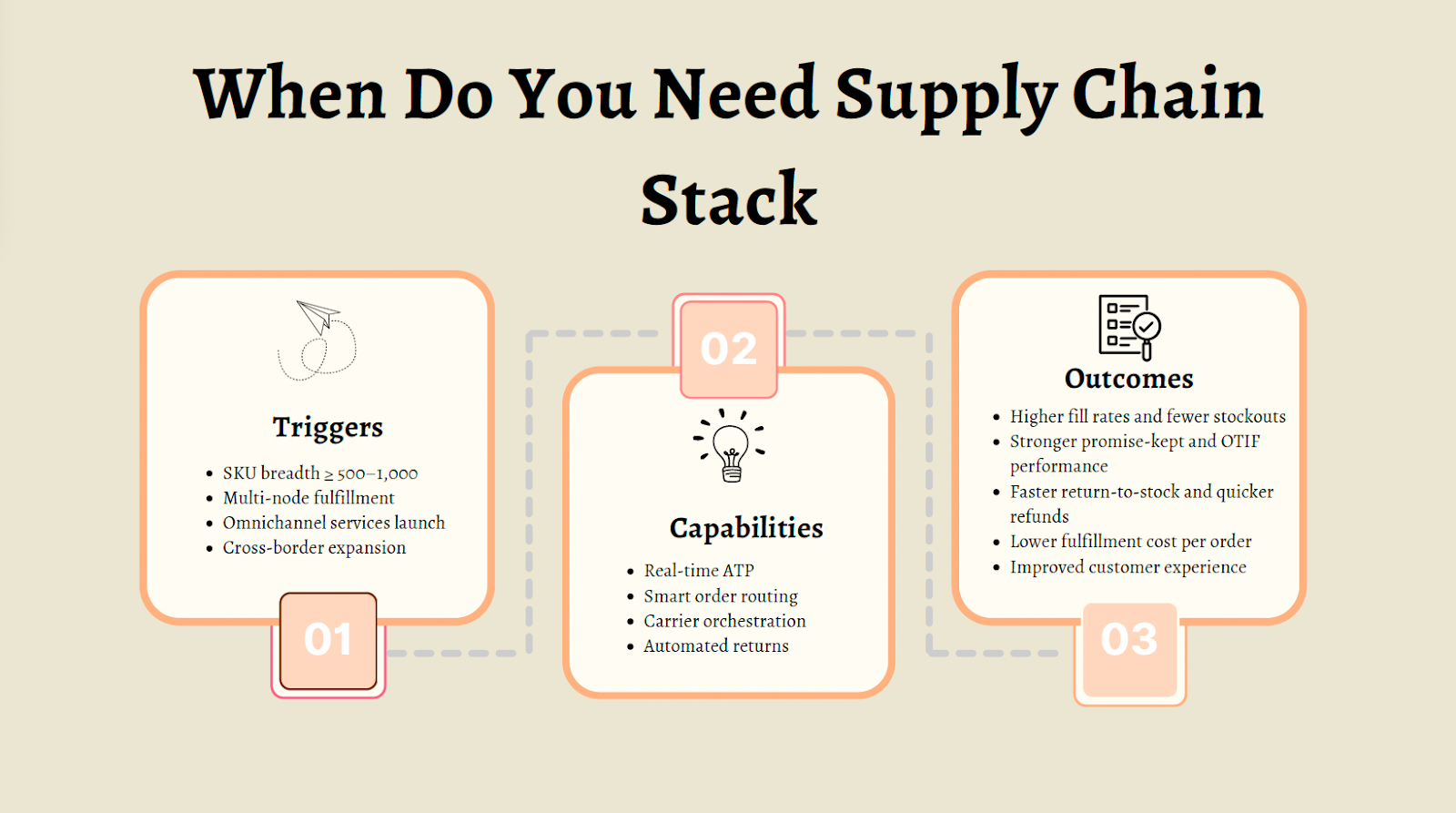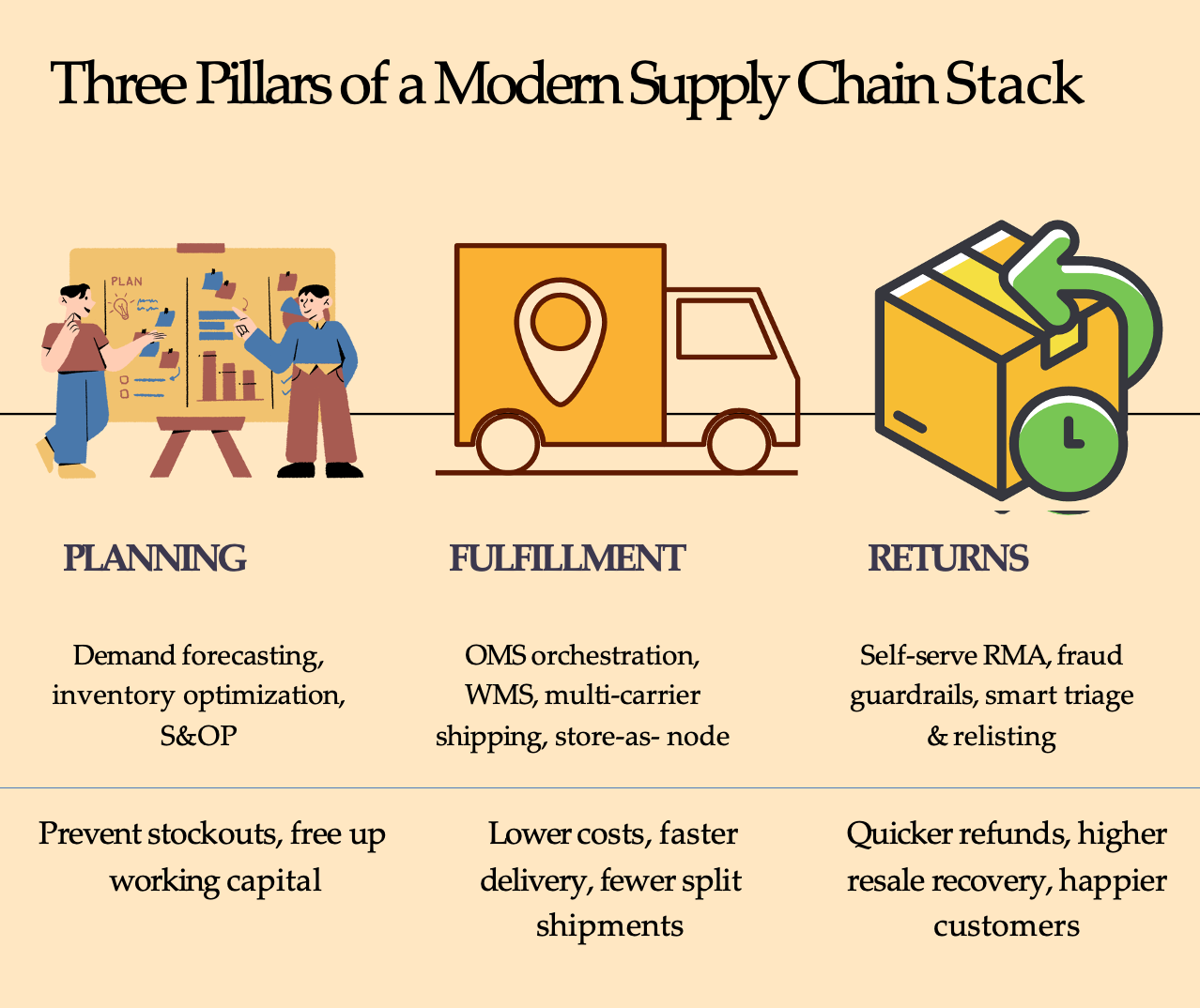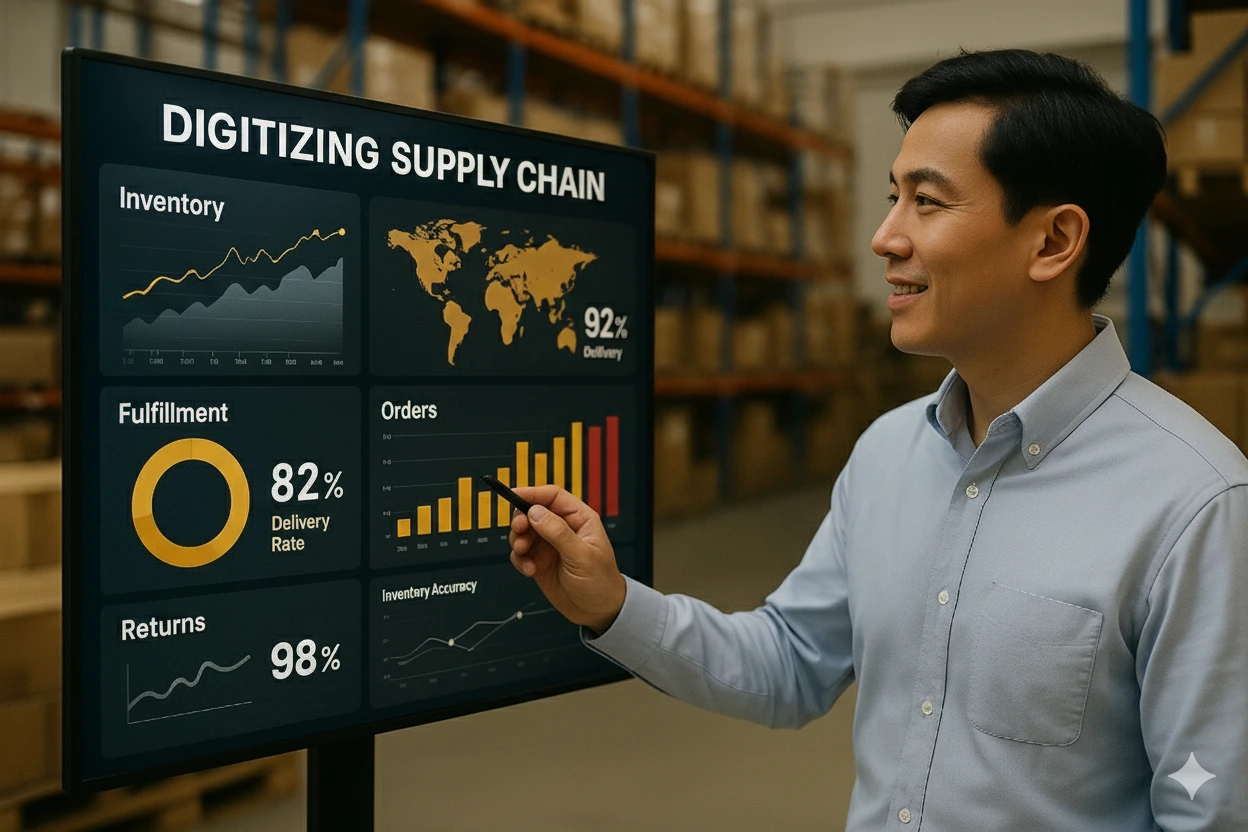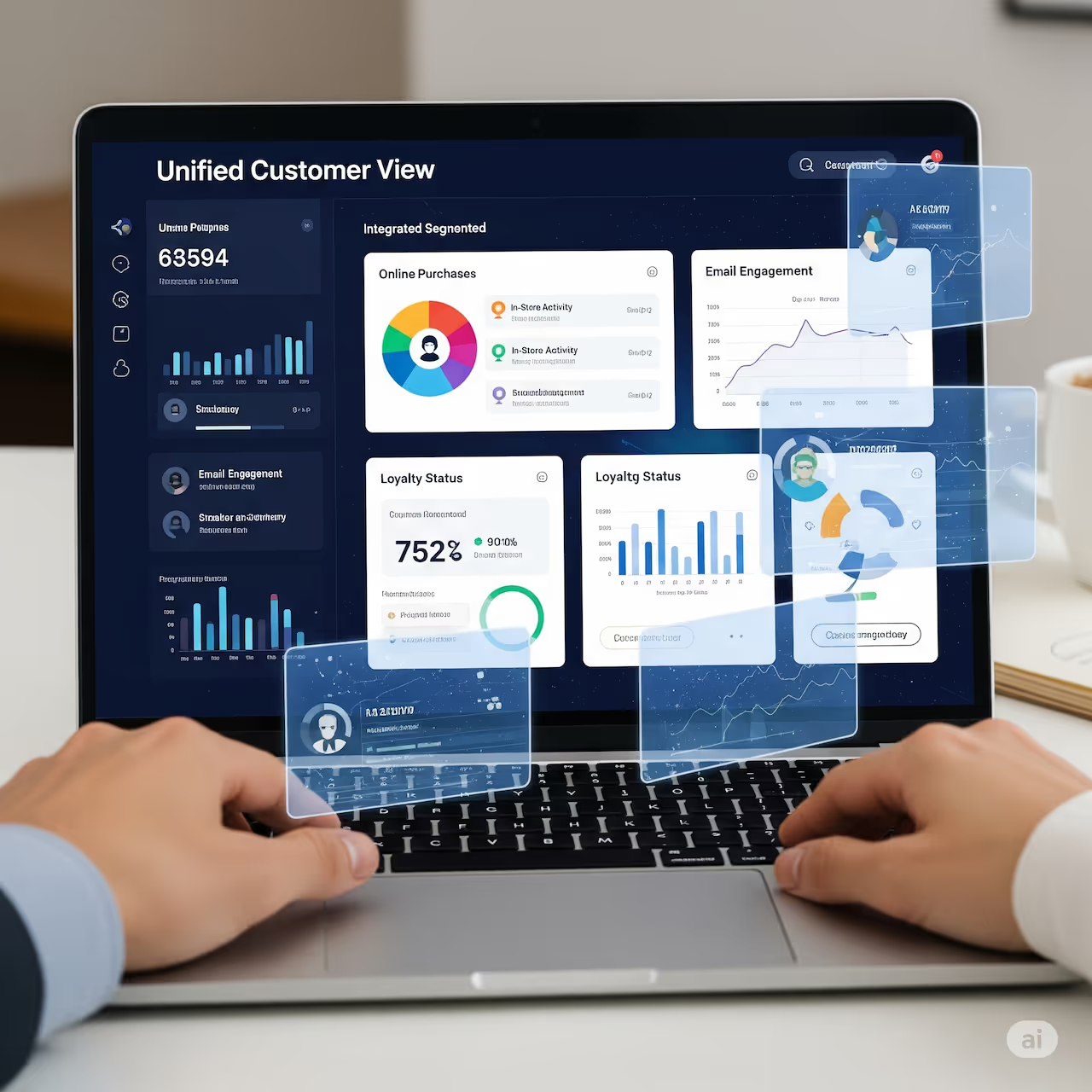Fragmented data is a quiet killer. When inventory lives in your ERP, orders flow through a separate OMS, POS systems export on their own schedule, and marketplaces refresh whenever they choose, you are not just flying blind. You are bleeding margin with every misaligned decision.
The old way of running supply chains, stitching together ERP reports, warehouse spreadsheets, and manual returns processes, creates costly gaps. Phantom inventory leads to overselling. Split shipments drive up fulfillment costs. Returns sit in limbo while cash stays tied up. Each disconnected system becomes a leak in your operational efficiency.
Modern supply chains flip this script entirely. They are built as a unified, near real-time stack where planning, fulfillment, and returns all run on the same source of truth. Think of it as a connected nervous system that keeps goods flowing from supplier to shelf to shopper seamlessly.
There are three critical elements of this interconnected system:
- Planning covers demand forecasting, inventory optimization, and sales and operations planning (S&OP).
- Fulfillment spans order management, warehouse and store execution, carrier orchestration, and store-as-node.
- Returns include return automation, triage, refurbish and relist, and reverse logistics.
We will dive into each of these elements in a bit. But first, why should you care?
If you head operations, digital, or supply chain at a mid-market retail and CPG brand with 5–200 stores and are witnessing higher stockout rates, more split shipments, high fulfillment costs, and longer return-to-stock cycles than your peers, this article is for you. Because for emerging retail leaders, a modern supply chain isn’t a “future ambition,” it’s a near-term requirement.
From Cost Leaks to Competitive Edge
A disconnected supply chain does not just slow you down. It erodes margin, misses SLAs, and weakens customer trust. The hidden costs of fragmented systems add up faster than you imagine.
A modern supply chain addresses the root causes and delivers measurable impact:
- Data fragmentation fixed → Revenue growth. When ERP, POS, WMS, and marketplaces run on the same clock, phantom stock disappears, ATP improves, and lost sales decline.
- Broken promise logic solved → Margin protection. An OMS with full visibility routes orders by true availability and node capacity, cutting overselling, split shipments, and freight waste.
- Reverse loop closed → Working capital unlocked. Automated returns triage and restocking update ATP quickly, freeing up cash and moving inventory back into circulation faster.
- Carrier silos unified → SLA adherence. Centralized carrier orchestration lowers costs, reduces brittle dependencies, and keeps OTIF performance intact.
- Consistent execution → Customer trust. Reliable promises, faster refunds, and smoother post-purchase experiences build loyalty and repeat business.
The business impact of supply chain digitization is measurable. It shows up in revenue growth, margin protection, smoother operations, and stronger customer loyalty.
Do You Need a Modern Supply Chain Stack?
Like every other tech stack, you don’t need the full supply chain stack on day one. The tell is in your signals.If you’re seeing a mix of scale pressures, process gaps, and frontline breakdowns, you’ve outgrown spreadsheets and point tools. Use the checklist below—growth triggers → execution gaps → operational breakdown—to decide if it’s time to modernize.
🔹 Growth Triggers
- SKU breadth crosses 500–1,000, often with seasonal spikes
- Expansion into multi-node fulfillment such as DCs, 3PLs, or ship-from-store
- Launching omnichannel services like BOPIS or ship-from-store introduces new fulfillment complexity
- Cross-border sales add customs steps and multiple local carriers
🔹 Execution Gaps
- Inventory across ERP, POS, and marketplaces such as Shopee or Lazada is out of sync
- Orders are increasingly split, driving up costs and complaints
- Returns take weeks to credit or restock because processes are not automated
- Forecasts and replenishment live in spreadsheets with no audit trail
🔹 Operational Breakdown
- Stockouts occur despite full inventory because ATP is stale or stock is in the wrong node
- Service levels slip when supplier lead times swing and last-mile partners do not stay in sync
- Returns sit in limbo, lose resale value, and slow refunds
- Teams waste hours reconciling COD refunds and processing RMAs manually
If three or more of these apply to your business, you have likely reached the tipping point.

Three Pillars of a Modern Supply Chain Stack
A modern supply chain stack is built on three tightly connected pillars: planning, fulfillment, and returns. Each plays a distinct role, and together they form the backbone of how goods move from supplier to shelf to shopper.
Planning : The brain of the operation.
- Demand Planning & Forecasting: Must factor in promotions, seasonality, and external signals. (e.g., Blue Yonder, o9 Solutions, Relex Solutions )
- Inventory Optimization (MEIO): Right stock at the right node, instead of holding excess buffers everywhere.
- S&OP: S&OP aligns sales forecasts with supply capacity and financial plans. (e.g., Anaplan, SAP IBP)
Checks: Real-time latency, override workflows, and forecast accuracy tracking.
Fulfillment : The execution engine.
- OMS orchestration: Routes orders by margin, SLA, and node capacity.
- WMS/Store Fulfillment: Efficient slotting, accurate picking, and smooth ship-from-store operations.
- Carrier orchestration: Automates choosing the best carrier, generating labels, and creating shipping documents.
Checks: Real-time inventory sync, store-as-node support, and dynamic routing logic.
Returns: Turn pain into advantage.
- RMA automation: Self-serve portal, instant labels, guardrails for fraud.
- Triage & disposition: Quick decision on whether a returned item should be restocked, refurbished, recycled, or returned to the vendor (RTV)
- Reverse logistics: Pickup/drop-off networks, automated refunds/exchanges.
Checks: ATP updated on restock, fraud scoring in place, and disposition SLAs.

These three pillars form the foundation of a connected supply chain. With them in place, you can then move to evaluation—comparing systems not only by features but also by how well they connect, perform, and scale.
How to Evaluate a Modern Supply Chain Stack
Once you understand the three pillars—planning, fulfillment, and returns—the next step is to evaluate how platforms actually deliver on them. Not all systems are created equal. A future-ready stack is defined not just by features but by how well it integrates, scales, and safeguards your operations. Let's look at the evaluation parameters under each pillar.
Planning: The Brain of the Operation
Core Systems
- Demand planning and forecasting factors in promotions, seasonality, and external signals.
- Multi-echelon inventory optimization (MEIO) to keep the right stock in the right node without excess buffers
- Sales and Operations Planning (S&OP) workspaces to align sales forecasts with supply capacity and financial plans
- Master Data Management (SKU, location, customer) and near real-time data integration via CDC or event streaming.
Integrations, Costs, and Governance
- Connects to ERP, POS, e-commerce platforms, marketplaces, OMS, and supplier portals
- Pricing should be transparent with clear data volume and integration costs, sandbox access included, and minimal setup effort for model tuning
- ISO/SOC2 compliance, GDPR/PDPA alignment, RBAC and audit logs, uptime at or above 99.9 percent
Watch-outs: Avoid black-box AI with no override options, batch-only ingest, long setup cycles, limited data exports, and vendor lock-in. Look out for a public 12-month roadmap, versioned APIs, implementation playbooks, and access to a named CSM.
Fulfillment: The Execution Engine
Core Systems
- OMS suite with dynamic routing that optimizes by margin, SLA, and node capacity, with store-as-node support
- Inventory and ATP services, store-fulfillment apps, and WMS for DCs
- Carrier orchestration to automate carrier selection, label generation, and shipping documents
- Integration layer via iPaaS, EDI, or event streaming for real-time sync
Integrations, Costs, and Governance
- Connects to ERP, POS, marketplaces, TMS, 3PLs, carrier APIs, and ATP services
- Usage-based pricing with clear disclosure of label and manifest pass-through fees, peak or expedite surcharges, sandbox access, and rollout costs
- Published RTO and RPO targets, uptime SLAs, RBAC, audit logs, incident reporting, and data retention traceability
Watch-outs: Avoid single-carrier lock-in, hidden label or webhook fees, batch-only inventory sync, brittle custom middleware, and metered pricing surprises. Look out for rollout playbooks, store onboarding toolkits, connector libraries, regional support hours, and time-to-go-live commitments
Returns: Turning Pain Into Advantage
Core Systems
- RMA platforms with fraud and abuse screening
- Reverse-logistics orchestrators with triage and disposition options (restock, refurbish, relist, recycle, RTV)
- Refund and exchange automation integrated with PSPs
- Integration layer for real-time updates via iPaaS or event services
Integrations, Costs, and Governance
- Connects to OMS, ERP or finance systems, PSPs, marketplaces, CRM and loyalty systems, carriers, and return networks
- Clear pricing per return or as a percentage of GMV, with disclosed reverse-logistics fees, inspection and refurb charges, and exchange fees
- PII masking, safe handling of images, GDPR deletion requests, RBAC and audit logs, uptime SLA, and evidence chains for disputes
Watch-outs: Avoid lack of export options, refunds tied to a single PSP, manual approvals only, items stuck in limbo, poor cross-border options, and limited drop-off coverage. Look out for exit packs, named CSM support, multilingual assistance, refund and credit SLA guidance, and implementation playbooks

Key Questions to Ask Vendors
When evaluating platforms, focus less on demos and more on how they perform in the real world. These 5 clusters of questions reveal the truth:
- Inventory and Orders
- How do you unify online and offline inventory in near real time?
- How does your OMS make routing decisions by margin, promise date, and node capacity?
- Fulfillment and Stores
- Can physical stores act as fulfillment nodes with the same visibility as DCs?
- How do you manage multiple carriers centrally to cut costs and protect SLAs?
- Returns and Fraud
- What share of RMAs can be auto-approved with fraud guardrails?
- How quickly are returned items restocked and refunds processed?
- Data and Portability
- If we switch vendors, do we get full exports with schemas and no hidden exit fees?
- How are demand forecasts tracked, audited, and adjusted without IT bottlenecks?
- Support and Roadmap
- What SLAs and support coverage are guaranteed, and what is extra?
- Which AI-driven features are live today, and what is on the 12-month roadmap?
Modern Supply Chain OS: One Backbone, Real-Time Flow
A modern supply chain stack unifies planning, fulfillment, and returns on a single, real-time backbone. When the data lines up, the day-to-day gets lighter: fewer stockouts, smarter routing, lower freight and handling costs, and refunds that move without nudges.
Promises stop slipping because ATP, OMS, WMS, and returns all see the same truth. That consistency allows you to keep commitments with confidence, protect margin, and win trust.
For growing retailers and CPG brands, this is no longer optional. A modern supply chain stack is the operating system for hitting SLAs, improving working capital, and building repeat business. The impact shows up in your customer experience and in your P&L.
Next Steps
- Take a baseline: Where do inventory, orders, and returns fall out of sync, and what is the cost in service or margin?
- Stress-test your shortlist: Can vendors prove impact on your own data and answer the hard questions clearly?
- Start small, measure hard: Pilot in one node or channel, track KPIs such as fill rate, OTIF, and return-to-stock time, and scale what works.
- Get one plan: Align sales, supply, and finance on the same cadence so decisions and numbers match.
- Design for scale: Ensure the stack can extend to more carriers, markets, and formats without long setup cycles or lock-in.
👉 Start mapping your Supply Chain Stack, and when you are ready, explore tools that can bring it to life.


.avif)


.avif)